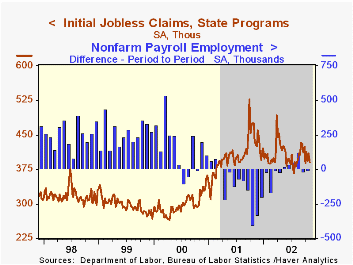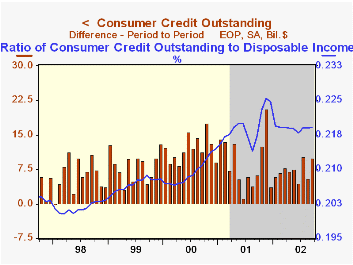 Global| Nov 07 2002
Global| Nov 07 2002Nonfarm Productivity Growth Strong in 3Q
by:Tom Moeller
|in:Economy in Brief
Summary
Nonfarm labor productivity grew as expected last quarter. Consensus estimates were for growth at a 4.1% rate. While growth was more than double the 2Q rate, it was roughly half the heated growth of 4Q01 and 1Q02. Output in the nonfarm [...]

Nonfarm labor productivity grew as expected last quarter. Consensus estimates were for growth at a 4.1% rate. While growth was more than double the 2Q rate, it was roughly half the heated growth of 4Q01 and 1Q02.
Output in the nonfarm business sector rose a strong 4.0% (AR). That's versus 3.1% in real GDP last quarter. Hours worked were unchanged. Hours worked generally have been declining since early 2000.
Unit Labor costs rose at half the 2Q rate; up in the last two quarters after three consecutive quarters of decline. Compensation growth was strong the last three quarters.
Manufacturing sector productivity grew a strong 5.9% (5.9% y/y). Unit labor costs fell 1.3%, the fifth consecutive quarterly decline.
For analysis of the recent resurgence in US productivity growth by the Atlanta Fed, click here.
| Nonfarm Business Sector (SAAR) | 3Q '02 | 2Q '02 | Y/Y | 2001 | 2000 | 1999 |
|---|---|---|---|---|---|---|
| Output per Hour | 4.0% | 1.7% | 5.3% | 1.1% | 2.9% | 2.4% |
| Compensation | 4.8% | 3.9% | 3.3% | 2.7% | 6.9% | 4.4% |
| Unit Labor Costs | 0.8% | 2.2% | -2.0% | 1.6% | 3.9% | 2.0% |
by Tom Moeller November 7, 2002

Initial claims for unemployment insurance fell more than expected in the latest week. Claims in the prior week were unrevised.
The four-week moving average of initial claims rose slightly to 402,00, down 13.4% y/y.
Continuing claims for unemployment insurance rose marginally, but the prior week's sharp increase was halved.
The insured rate of unemployment was stable at 2.8% for the third consecutive week.
| Unemployment Insurance (000s) | 11/02/02 | 10/26/02 | Y/Y | 2001 | 2000 | 1999 |
|---|---|---|---|---|---|---|
| Initial Claims | 390.0 | 410.0 | -10.1% | 405.8 | 299.8 | 297.7 |
| Continuing Claims | -- | 3,583 | 0.1% | 3,021 | 2,114 | 2,186 |
by Tom Moeller November 7, 2002

Consumer credit outstanding rose $9.9B (0.6%) in September, nearly double the prior month's growth and higher than Consensus expectations for a $6.0B rise. August figures were revised up due to sharply raised figures for revolving credit. So far this year, consumer credit outstanding has risen at a 5.3% annual rate.
Revolving credit rose 0.8%, the same as in August which was revised from 0.5%. Revolving credit growth was 5.6% (AR) through September.
Nonrevolving credit grew 0.4% after falling slightly in August. Nonrevolving extension was up 5.0% (AR) YTD.
| Consumer Credit Outstanding | Sept m/m | Aug m/m | Y/Y | 2001 | 2000 | 1999 |
|---|---|---|---|---|---|---|
| Total | $9.9B | $5.6B | 6.3% | 6.9% | 10.2% | 7.5% |
| Revolving | $5.6B | $6.0B | 4.4% | 5.0% | 11.5% | 6.3% |
| Nonrevolving | $4.3B | $-0.4B | 7.7% | 8.3% | 9.2% | 8.4% |
Tom Moeller
AuthorMore in Author Profile »Prior to joining Haver Analytics in 2000, Mr. Moeller worked as the Economist at Chancellor Capital Management from 1985 to 1999. There, he developed comprehensive economic forecasts and interpreted economic data for equity and fixed income portfolio managers. Also at Chancellor, Mr. Moeller worked as an equity analyst and was responsible for researching and rating companies in the economically sensitive automobile and housing industries for investment in Chancellor’s equity portfolio. Prior to joining Chancellor, Mr. Moeller was an Economist at Citibank from 1979 to 1984. He also analyzed pricing behavior in the metals industry for the Council on Wage and Price Stability in Washington, D.C. In 1999, Mr. Moeller received the award for most accurate forecast from the Forecasters' Club of New York. From 1990 to 1992 he was President of the New York Association for Business Economists. Mr. Moeller earned an M.B.A. in Finance from Fordham University, where he graduated in 1987. He holds a Bachelor of Arts in Economics from George Washington University.






